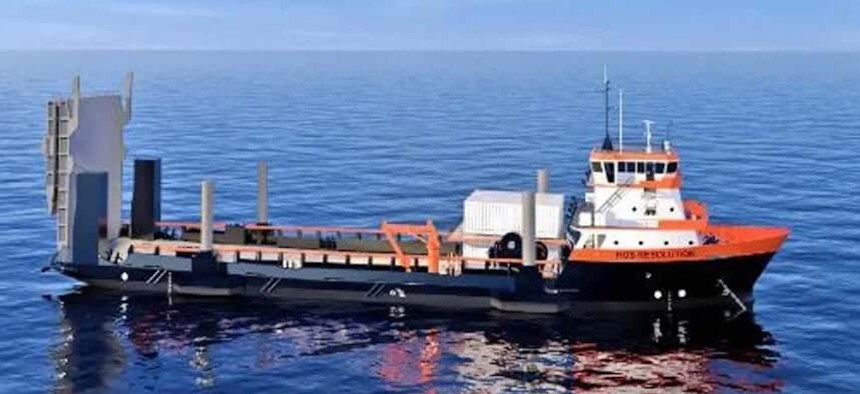
HOS Resolution, as modified by Hornbeck Offshore for Marine Corps experiments. U.S. Marine Corps Warfighting Laboratory
Leased Ship Will Shape USMC Amphib Requirements
The Marine Corps Warfighting Lab will wring out modified commercial ships to learn what is needed in future amphibious ships.
The Marine Corps will experiment on the commercial ship it leased to help decide what capabilities its planned medium landing ships will require, officials said.
The Marine Corps Warfighting Lab plans to lease a total of three Stern Landing Vessels, or SLVs. The first has been heavily modified and is expected to arrive in San Diego for testing and evaluation in late March or early April. The other two are likely to be leased next year, and may sport different modifications. After the experiments, they will become part of a “bridging solution” for shore-to-shore operations.
“There’s a lot of work upfront that we need to do to make sure that this ship is safe to operate,” Jeff Tomczak, the Lab’s deputy director of science and technology, told reporters Monday. “It's been a long time since the Navy has beached ships ashore. The old [landing ship, tanks] are the last ships that were out there. So we're getting back into it.”
Working with the Military Sealift Command, the Lab hired Louisiana-based Hornbeck Offshore Services to add a large ramp to make the first ship “more beachable.” The shipyard also added landing legs for stability, built attachments to protect the rudders and propellers, and reinforced the deck “so that it can carry everything in the Marine Corps inventory,” said Lt. Col. Timothy Smith, logistics combat element lead for the warfighting lab. Smith said all this will help the Lab “to learn how stern landing vessels actually work in surf conditions.”
This first Stern Landing Vessel can carry 38 Marines as well as a 12- to 15-person commercial crew, and has 6,000 square feet of cargo space on a wet deck. It also has sleeping and eating quarters. Tomczak said that unlike a Landing Craft Utility, which can also transport troops and equipment to the shore, the SLV is a “stay-at-sea ship” and can travel long distances or stay afloat for significant periods of time without returning to land.
Smith said the Marine Corps would like to eventually have a flight deck for unmanned flights, to support “better ship-to-shore logistics support,” but first the service needs to experiment with the current model and decide what works and what doesn’t.
The Marines need a vessel with these capabilities because “there’s a demand and there’s a need to be able to move things in and around the Pacific,” Tomczak said. “What makes things different in the Pacific than anywhere else we’ve operated recently is the fact that it’s predominantly water. And because it’s water, we need surface vessels, air vessels, primarily to move things. And there’s less emphasis, obviously, on ground vehicles, because there’s not much of that out in the South China Sea. There’s not much of that out in the Pacific."
Knowing that requirement, the warfighting lab will use its SLV experiments to “define other gaps and shortfalls that we have not identified at this time, that will eventually turn into warfighting requirements, that will eventually turn into future programs of record,” he said.
Marine Corps Commandant Gen. David Berger has repeatedly said the service will need at least 35 medium landing ships to support its new Marine Littoral Regiments, but the Navy has pushed back procurement of those ships to 2025. It also recently announced it was taking a “strategic pause” in buying amphibious ships, Defense News reported.




